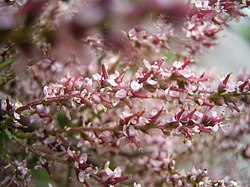| Tamarix gallica | |
|---|---|
 | |
| Scientific classification | |
| Kingdom: | Plantae |
| Clade: | Tracheophytes |
| Clade: | Angiosperms |
| Clade: | Eudicots |
| Order: | Caryophyllales |
| Family: | Tamaricaceae |
| Genus: | Tamarix |
| Species: | T. gallica |
| Binomial name | |
| Tamarix gallica | |
| Synonyms | |
| |

Tamarix gallica, also known as the French tamarisk, [2] is a deciduous, herbaceous, twiggy shrub or small tree reaching up to about 5 meters high.
Contents

It is indigenous to Saudi Arabia and the Sinai Peninsula, and very common around the Mediterranean region. It is present in many other areas as an invasive introduced species, often becoming a noxious weed. [2] It was first described for botanical classification by the taxonomist Carl Linnaeus in 1753, but had already been in cultivation since 1596. [3]
